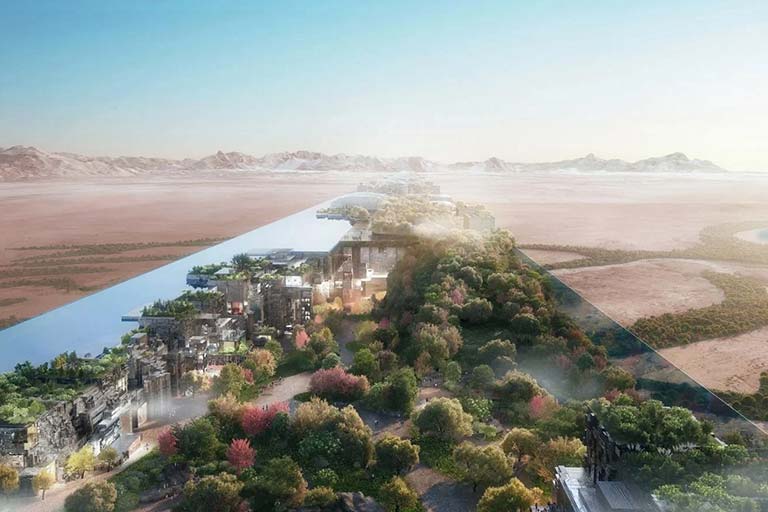A linear smart city is under construction in Saudi Arabia that is designed to have no cars, streets or carbon emissions, and will be powered entirely by renewable energy.
As part of the Saudi Vision 2030 project, The Line is part of Neom – a $500bn smart redevelopment of a 26,500km2 stretch of land that sits at the northern tip of the Red Sea.
Here in the historic province of Tabuk is where the group of mega projects that make up Neom’s smart city complex will be constructed. These include Neom Bay and Neom Bay Airport, as well as a floating industrial complex known as the Oxagon and 6,500 hectares of agricultural land.
Neom’s industrial expansion will be married with ambitious hospitality projects, including the Saudi Arabian peninsula’s first major outdoor skiing facility and a luxury resort complex featuring three hotels and a sprawling marina.
A new model city?
The jewel in Neom’s crown, though, is arguably The Line. Set to span 170km, it will stretch east to west from the Red Sea coast all the way to the city of Tabuk. Its unique design features a central outdoor space flanked by two 500m-tall, steel-built mirrored buildings that will house nine million residents once completed.
Designed as an alternative to traditional city structures that spread in all directions from a central point, The Line will have a footprint of just 34 km2, putting all daily needs within a five-minute walk for its residents.
 Beginning at the Red Sea, The Line will span 170km, with The Line’s residents traversing the city using a steel-built high-speed rail system
Beginning at the Red Sea, The Line will span 170km, with The Line’s residents traversing the city using a steel-built high-speed rail system
Its linear structure confronts many of the issues facing modern cities, including the overpowering presence of automobiles, ongoing urban sprawl, and the air pollution found at the heart of large municipal centres.
Powered entirely by renewable energy, the zero-car city will also feature a steel-built, high speed rail system with an end-to-end transit of just 20 minutes.
A zero-carbon nature corridor in the desert
Another benefit of the city’s unique layout is it’s lessened impact on nature and biodiversity. The linear model does not affect a region’s natural resources the way a traditional sprawl would, instead curated flows for water and wildlife will be integrated into the city’s ground plane.
The stunning mirrored surfaces of The Line’s buildings will also be given façade treatments to prevent bird deaths by collision, and the structure will be aligned with migratory patterns.
 The Line will only cover a 34 square kilometre footprint, limiting its impact on the natural environment
The Line will only cover a 34 square kilometre footprint, limiting its impact on the natural environment
The Line is also designed as a ‘net-zero carbon city’, with a dedicated research team using the greenest construction materials possible, taking into account the supply chain and operational emissions from the structure’s usage. The project will also be supported by technologies that remove atmospheric carbon, as well as offsetting.
For a project of this scale and ambition, the Neom team are exploring digitised and modular design to minimise environmental impact and reduce build time. In addition to being 100% recyclable, structural steel can be precision manufactured offsite, simplifying on-site assembly and speeding up the construction process.
With steel-built innovations at its heart, The Line represents a unique opportunity to set a new benchmark for sustainable, liveable cities.
Images: Neom